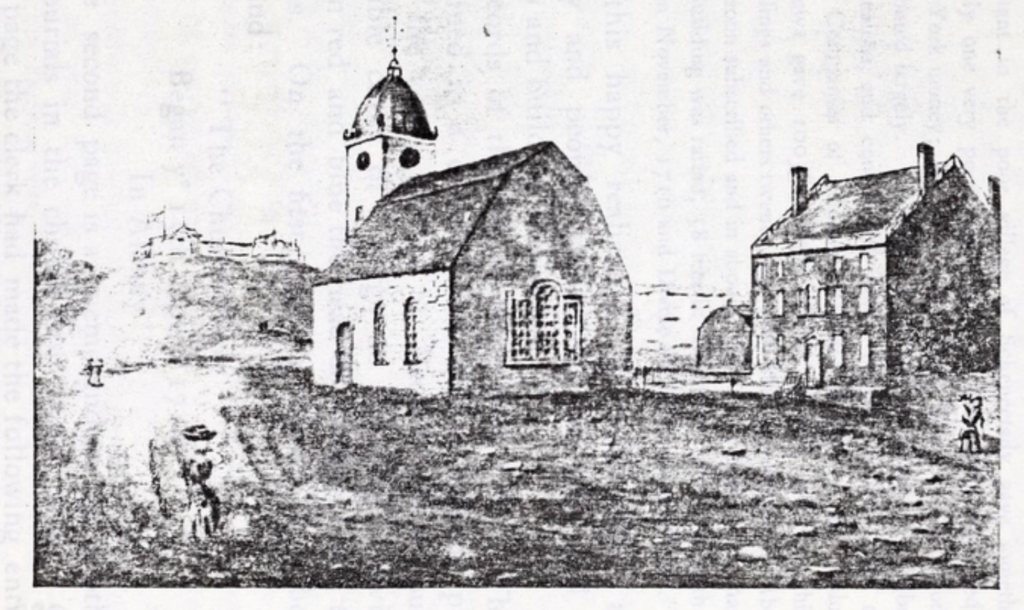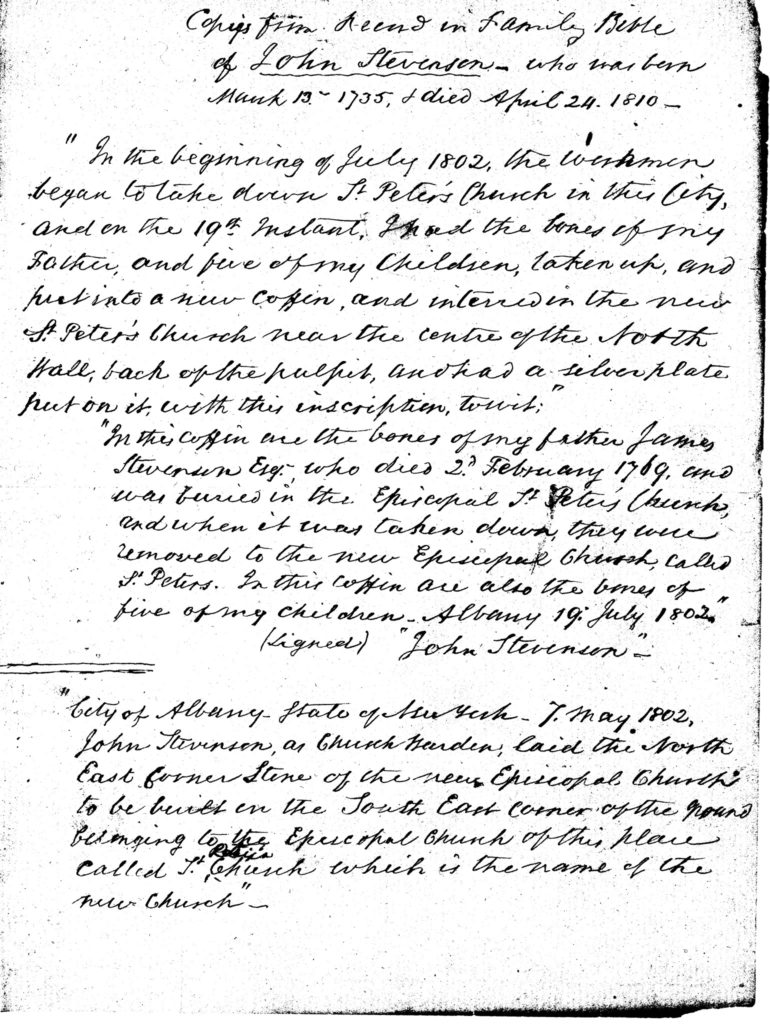Continuing our series on the bronze markers that were placed by the Albany Bicentennial Committee in 1886 – the words below were approved to commemorate the first English church in Albany:
Tablet No. 7—First English Church
Located in the walk, near the curb, north-west corner of Chapel and State streets. Bronze tablet, 11×23 inches, set in the top of a granite block 21×33 inches square and 16 inches high above the sidewalk—will have a slanting top to shed water. On it will read :
“Opposite in middle of State street stood the First English Church Erected A. D. 1715—Removed and Rebuilt as St. Peter’s church 1803 on next corner west. Rebuilt 1859.”
There is no longer a northwest corner of Chapel and State, although we suspect Chapel still exists there on paper. It is a driveway between the Hilton hotel and the bank building that holds down the Elm Tree corner. There are notable markers nearby in the center islands, thoughtfully placed so that pedestrians waiting forever for drivers to acknowledge the walk signals have something to read while they wait. One of those notes the location of the Market House, which does not seem to have been a bicentennial installation.
A 1914 report in the Albany Argus notes that while the bicentennial report said this tablet was to be set in the northwest corner of Chapel and State streets, it was never placed there, “but a tablet with a more elaborate inscription was placed on the front wall of St. Peter’s church.” This would explain why the tablet at St. Peter’s doesn’t say what the committee said it would.

The tablet that was actually cast looks entirely different from the other bicentennial tablets, and includes much more church history:
In the middle of State, formerly Yonkers Street, one block below, stood the First English Church, built A.D. 1715, upon ground granted by letters patent from King George the First. It bore the name of St. Peter’s Church. The Parish was incorporated A.D. 1769. The Second St. Peter’s Church was built on this Site A.D. 1802, and bore this inscription: Glory be to the Lord, for He is good; for His mercy endureth forever. The present edifice was built A.D. 1859. Upon this spot stood the north east bastion of Fort Frederick.
The First English Church
Recall that despite the colony having been taken under English rule in 1664, Albany was Dutch, Dutch to the core, and a few English soldiers and government officials didn’t change that. In 1704, Albany was described to Church of England clergy in New York as:
“A large frontier town where most of the people are Dutch, who have from Amsterdam a Dutch minister, one Mr. Lydius, but there are some English families, besides a garrison of Soldiers, who are a considerable congregation. A Church of England minister here will, in all probability do signal service, not only by setting up public worship to the joy and comfort of the English, who impatiently desire a minister, and persuading the Dutch and others to conform, but also instructing the Indians which come in greater numbers thither.”
Quoted in Hooper’s “A History of St. Peter’s Church in the City of Albany,” p. 85, referring to “Doc. Hist. N.Y. Vol. III, p. 117”
It would be 1708 before an English church clergyman, Rev. Thomas Barclay, would be commissioned at the fort, which then contained a garrison of 200 soldiers. Barclay was also named missionary to Native Americans who came to Albany, as well as the enslaved persons (which made up about 450 of Albany’s 4000 people in 1712). Barclay wrote in 1710 that he was catechising “a great many Dutch children, who at my first arrival were altogether ignorant of the English tongue,” as well as preaching at Schenectady’s garrison of 40 soldiers as well as 16 English families and 100 Dutch; there had been no Dutch minister there for five years. In Albany, Lydius, the Dutch minister, died in March 1710, with no replacement for more than a year. The English church services were taking place in a “much decayed” small chapel belonging to the Dutch church.
In 1714, Governor Robert Hunter granted license to Rev. Barclay to collect money for the building of a church “in the centre of the broad street called Yonkers Street, leading from the fort to the waterside, between the end of Pearl Street and the small street that leads to the Lutheran Church.” It was later decided that a location on the hill nearer the fort would allow more room for church and cemetery. But still, being Albany, the center of the street seemed a perfectly reasonable place to put a church.
Hooper writes that “soon after the patent was received, workmen began to lay out the plot granted in the middle of the street.” This site would lead to a dispute between the province of New York, which granted the patent, and the City of Albany, which determined that “the right of the Crown to convey land without any title from the City ought to be tested.” Work on the foundation had begun in November 1714, and legal battles ensued, with Albany taking legal action against workmen at the site. The issue was ultimately resolved in the church’s favor, and the church opened Nov. 25, 1716.
Hooper’s history says very little about the physical church building; it contains this photograph of a water color meant to represent the church, but on what basis the watercolor was made, we do not know. It could be right or wrong:

The Second Church: St. Peter’s
By 1796, according to Hooper, it was recognized that the congregation had outgrown the original church. Now known as St. Peter’s, they already had rights to purchase a lot at Barrack (Chapel), Steuben, Lodge and Pine Streets. The sale/exchange was complicated – church properties were assessed in those days, and there was the matter of wanting the old church’s steeple left standing, for it was from there that the fire bell rang. There were other matters under consideration, such as the potential joining of the Lutherans, who used the same church building, with the English Episcopalians, such that the matter was put off for some years. It would be January 1802 before there was a contract made with Philip Hooker, Elisha Putnam, Garrett W. Van Schaick and Samuel Hill to “erect, build and complete a stone Church on the lot of ground in the first ward of the City of Albany at the intersection of State and Lodge streets.” The church was to be completed by June 15, 1803. A new cornerstone was laid May 7, 1802.

“When the first St. Peter’s was torn down, the bodies of all those buried within the church were carefully removed and re-interred under the tower of the second building. Among them were the remains of the gallant Lord Howe, who fell at Trout Brook, July 6, 1758, in the campaign against the French. A payment of seventeen dollars and a half ($17.50), was made to Adam Todd, the sexton, ‘for raising, removing, and interring, the remains of 35 persons from the interior of the old Church in State Street when demolished to the new Church now building.”

Thanks to contributor Adrian Brisee we have additional evidence that the bodies were, in fact moved, in the form of a record made in a Stevenson/Douw family bible. John Stevenson (1735-1810), a warden of the church who laid the cornerstone, wrote:
In the beginning of July 1802, the workmen began to take down St. Peter’s Church in this City, and on the 19th instant, I had the bones of my Father and five of my Children, taken up, and put into a new coffin, and interred in the new St. Peter’s Church near the centre of the North Hall, back of the pulpit, and had a silver plate put on it, with this incription, to wit:
‘In this coffin are the bones of my father James Stevenson Esq., who died 2d February 1769, and was buried in the Episcopal St. Peter’s Church, and when it was taken down they were removed to the new Episcopal Church, called St. Peter’s. In this coffin are also the bones of five of my children. Albany 19 July 1802.’
[signed] John Stevenson
A marble slab was to be placed above the pediment of the main entrance:

The Third Church
Construction on the third church, designed by Richard Upjohn of New York City, began in 1859, with demolition completed and the first foundation stone for the new church laid by April 8. In the course of that demolition, they discovered a somewhat mysterious stone, four feet long and one foot thick. “Upon its face cut in are the following letters of an ancient form, A.M.S. and A.N.O. joined together as one letter, bearing date, 1715.” Hooper says there is no record of laying any cornerstone for the first church, and that the stone work of that building was taken by Hooker and Putnam in partial payment. “It seems strange that a relic like that should have been allowed to be built into the foundation, if the authorities of St. Peter’s were aware of its value. It may not have been connected with the church, but a stone from the old fort, as the north-east bastion and other parts of the fort enclosure occupied the site of the present church. The stone does not appear to have been preserved.” In other words, we found a mysterious but potentially important stone, we didn’t know what it was about, and we lost it again.
On June 29th, 1859, with the foundation walls nearly completed, there was a large ceremonial placement of the new cornerstone, along with “a proper lead box to be placed under the stone, and a silver plate with a proper inscription to be deposited in that box, with such documents and other articles as the Committee may deem proper.” What they deemed proper included “the Bible and Prayer Book, the New York Convention Journal for 1858, photographs of the old church, a list of pew holders, a diagram of the old church, and a silver plate upon which was inscribed a brief record of the laying of the corner stone, the names of those connected with the building of the new church, and a concise history of the parish.” The first service in the new church was held September 16, 1860. While there have been some significant renovations, including the erection of the tower in honor of John Tweddle and interior renovations, the church still stands and functions some 160 years later.

This entry relies heavily on Hooper’s “A History of Saint Peter’s church in the city of Albany.”

Leave a Reply